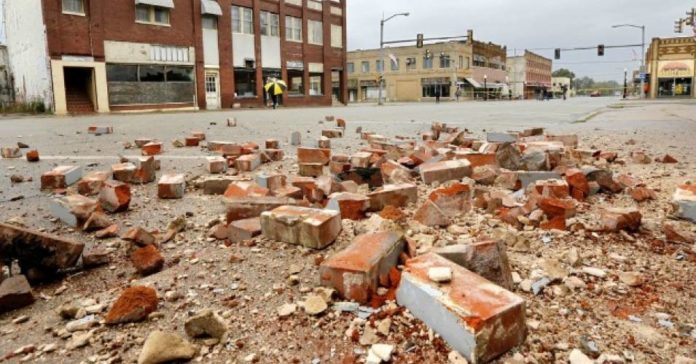For the last several years, something strange has been going on in Oklahoma. While the occurrence of earthquakes in the state usually hovers between one to three quakes annually, Oklahoma is now averaging one to three significant earthquakes per day.
According to a newly released USGS earthquake risk map, Oklahoma is now just as likely as San Francisco to experience a disruptive, damaging earthquake over the course of the next year. However, unlike San Francisco, Oklahoma’s heightened earthquake risk is not the work of any natural phenomenon, but rather a man-made one.
Unlike most earthquake-prone states in the U.S., Oklahoma isn’t located above an active fault line. Instead, Oklahoma is positioned on top of the Woodford oil and gas shale, which has been a hotspot for oil and gas development over the last decade. The Woodford Shale, which covers nearly the entire state and is known for its geological complexity, was among the first domestic natural gas formations to be tapped using hydraulic fracturing, or “fracking,” a highly controversial fossil fuel extraction technique proven to cause damage to the environment.
Among the technique’s many negative environmental effects is a rise in seismic activity, as it literally fractures bedrock through injections of pressurized liquid, known as “wastewater.” In addition to the documented toxicity of wastewater, its repeated injection deep into the Earth has been scientifically proven to stimulate major seismic events.
RELATED ARTICLES:
- EPA Plans to Allow Unlimited Dumping of Fracking Wastewater in the Gulf of Mexico
- Groundbreaking Study Confirms Link Between Fracking and Earthquakes
A 2016 study published in Science used Interferometric Synthetic Aperture Radar (InSAR) to show that wastewater injection causes a major buildup of pressure beneath the Earth’s surface by pushing groundwater potentially thousands of feet deeper underground. The study states that as displaced water travels down, it induces seismic activity, resulting in man-made earthquakes. The scientific evidence that fracking increases the incidence of such quakes is so compelling that the connection is even recognized by state and federal officials, despite fossil fuel lobbying efforts.
 The U.S. Geological Survey 2107 earthquake forecast map. (U.S. Geological Survey via AP)
The U.S. Geological Survey 2107 earthquake forecast map. (U.S. Geological Survey via AP)In Oklahoma, however, these earthquakes have been happening so frequently that they have been described as “swarms.” The dramatic spike in significant earthquakes has unsurprisingly coincided with the expansion of fracking throughout Oklahoma. Ever since Devon Energy drilled the state’s first fracking well in 2005, the number of significant earthquakes – those with a magnitude of 3.0 or greater – began to average two or more daily less than 10 years after the state’s fracking boom began. Earthquakes of that magnitude are easily felt and capable of inflicting damage on structures. While Oklahoma has introduced restrictions on the volume of wastewater injections, it has not been enough to negate the risk or incidence of earthquakes in the state.
Though energy companies like Devon Energy and Newfield Exploration have reaped huge profits by drilling in the Woodford Shale, Oklahoma residents will continue to feel the drilling’s seismic consequences long after extraction stops. As indicated in the 2016 Science study, seismic activity induced by fracking was found to increase even when injection rates at fracking wells declined, as previous injections at higher volumes had already caused the worst of the damage. Even if all fracking wells in the state were shut down tomorrow, fracking-induced earthquakes in Oklahoma would continue.
The economic fallout caused by unstable global oil prices has made the situation in Oklahoma even more complicated. While the price of oil per barrel was close to 100 dollars near the height of the boom, oil prices dropped significantly in 2015, reaching about 37 dollars per barrel in March of that year.
The price drop caused Oklahoma’s fossil fuel-dependent economy to contract by 2.4 percent in 2015, the worst performance nationwide at the time. Thousands of workers in Oklahoma were laid off as a result. Even after fracking becomes unprofitable or unfeasible, Oklahomans will be left with its unsavory environmental and economic impacts for years to come.
*Article originally appeared at anonhq.












